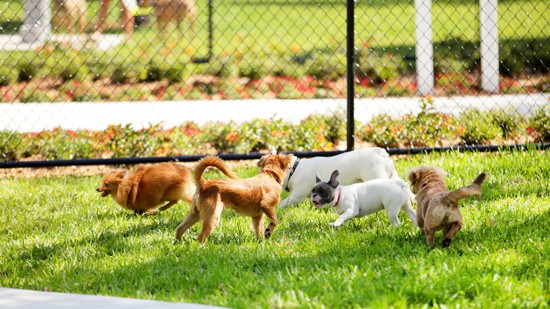Community dog parks are highly sought after, especially in areas where yard space is limited. Dog lovers need a place to let their dogs burn off energy and play with friendly companions. If you’re creating a dog park or redesigning an existing one, fencing is the most crucial factor. Check out these fence design tips for community dog parks, courtesy of All Around Fence.
Create Separate Areas for Large Breed and Small Breed Dogs
If you have enough space for two separate dog parks, designate a zone for large breed dogs and small breed dogs. Many large breeds are prey-driven, and smaller dogs come across as prey to them. Smaller dogs may also feel intimidated around larger breeds, creating an unpleasant experience for the dogs and the owners.
If the two zones are directly next to each other, you may want to add a privacy border between them. This blocks visibility so the dogs do not realize there are pets on the other side. If you don’t want a privacy fence, you could add privacy mesh along that fence line. Make sure to add noticeable signage for each zone designating which dogs are allowed in each area.
Choose a Fence That’s at Least 6 Feet Tall
Some community dog parks have 5′ fencing, but ideally, you should get fencing that’s 6′ high or taller. Many dog breeds can jump a 4′-5′ tall fence, so it’s best to err on the safe side. Nearly any fencing material can reach this height, so it will not limit your design options. Dog owners will appreciate the added security, and so will people passing by the dog park.
Use Metal Fencing for Maximum Durability
Most community dog park fences are made from metal. This could be chain link, wrought iron, aluminum, or another fencing material. The metal can stand up to the heavy wear and tear that dogs put on fencing. Wood fences are more subject to damage, and vinyl fencing may not provide the visibility you’re looking for. We’re happy to go over your options during your fence design consultation.
Provide Multiple Entry Points for Dog Owners (Self-Locking Gates)
Plan for multiple entry points around the perimeter of the dog park. This gives families the chance to enter a non-crowded area if the dogs are mostly gathered on one side of the park. If you have sidewalks or parking lots nearby, you may orient the entry points around those. Use secure self-locking gates to keep the dogs well contained in the park.
Additional Tips for Designing Community Dog Parks
Here are some more tips to help you design an amazing community dog park:
- Provide trash bags and waste stations throughout the park. If a dog owner forgets to bring bags, he will still have an easy way to clean up after the dog.
- Put signs on the gates for dog park rules and safety concerns. Every dog owner will have to come through the gate, so this guarantees that they can see the park rules.
- Offer water stations for the dogs. This could be a fountain with bowls for owners to use or a water trough that automatically fills with water as needed. This will keep the dogs hydrated as they play in the park.
- Add benches and seating for dog owners. You could ask community members to sponsor the benches and then display the sponsors’ names on the benches for recognition.
- Create an obstacle course for the dogs. This will take the dog park to the next level, helping the dogs work on agility and dexterity. Dogs get more tired from working their minds than they do from moving their bodies, making better use of the time at the dog park.
If you need of a dog park fence in Maryland, All Around Fence is here to serve you. We offer commercial fencing, residential fencing, and community fencing in Baltimore County, Howard County, Prince George’s County, and Anne Arundel County. Call (443) 838-9374 to schedule a no-obligation consultation.





